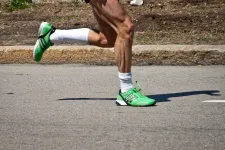With the current trend of fitness consciousness, many people have taken up long-distance running as a part of their exercise regime. They also participate in various local, national, and global marathons. But marathon running can lead to muscular fatigue and damage in the foot muscles, which can in turn lead to chronic pain or injuries. At present, there is little information on the impact of marathon running on the various foot muscles.
Foot muscles are generally categorized as either intrinsic or extrinsic muscles. While intrinsic muscles originate and insert within the foot, extrinsic muscles originate in the lower leg and insert into the foot via the ankle. Both muscle groups help stabilize the medial (inner) longitudinal arch of the foot. Although some studies have linked muscle swelling caused by long-distance running to lowering of the longitudinal arch, it has, so far, been challenging to associate this with intrinsic and extrinsic muscle damage.
Now, a new study explores the damaging effects of full marathon running on intrinsic and extrinsic foot muscles, and its association with changes in the longitudinal foot arch. The research team was led by Professor Mako Fukano from Shibaura Institute of Technology (SIT) and also included Kento Nakagawa from Waseda University, Ayako Higashihara and Takayuki Inami from Keio University, and Takaya Narita from Toin University of Yokohama. Their findings have been published online on 27 April 2023 in Scandinavian Journal of Medicine & Science in Sports.
The study recruited 22 college runners from track and field clubs that run at least 2–3 times weekly and had registered for a full marathon race at the Mt. Fuji International Marathon, either in 2019 or 2021. The researchers first assessed the magnetic resonance imaging (MRI)-based transverse relaxation time (T2), as an indicator of muscle damage, for the intrinsic and extrinsic foot muscles of the participants at four intervals: before the marathon, and 1, 3, and 8 days after they ran the full marathon. T2 is defined as the time taken by the transverse magnetization vector in an MRI to decay to approximately 37% of its initial value, and is influenced by tissue-specific characteristics.
The intrinsic muscles studied included the abductor hallucis (ABH), flexor digitorum brevis (FDB), and quadratus plantae (QP) and the extrinsic muscles included the flexor digitorum longus (FDL), tibialis posterior (TP), and flexor hallucis longus (FHL). The researchers also determined the longitudinal foot arch height via three-dimensional analysis of foot posture for 10 of these participants at the same time intervals as the T2 MRI to determine the changes in longitudinal foot arch height.
On comparison with the values of T2 before the marathon, the researchers observed that the T2 values of QP, FDL, TP, and FHL significantly increased one day after the marathon, and varied throughout the observation period. Further, they also found that increase in T2 of TP persisted three days after the marathon. However, they did not observe any major difference in T2 for ABH and FDB. The team also did not find any significant changes in the toe flexor muscle strength in any of the participants. Interestingly, they also noted that the arch height ratio statistically decreased from pre-marathon to 1 and 3 days after the race, and this change could be correlated with T2 changes in FDL and FHL.
“These results indicate that the damage and recovery response after a full marathon differs among the various foot muscles. For our research participants, all three extrinsic muscles and only one intrinsic muscle showed damage after marathon running, suggesting that extrinsic muscles could be more susceptible to marathon-induced damage than the intrinsic ones,” explains Prof. Fukano. This prominent damage to extrinsic foot muscles reflects the extensive pressure borne by the ankle joint while running for long-distances as compared to the rest of the foot— something other studies have also shown. Since QP is attached to FDL and/or FHL, it may also have a secondary function in running, along with extrinsic foot muscles, making it the only intrinsic foot muscle to get damaged by marathon running. Furthermore, the correlation between FDL and FHL and the longitudinal foot arch height indicates that marathon-induced damage to these extrinsic muscles could be a factor in decreasing the foot arch height.
“Since more people are now running for their fitness, our findings can provide runners and sports professionals insights on planning better recovery strategies focusing on muscle fatigue and damage to prevent running-related injuries and also improve runners’ conditioning,” concludes Prof. Fukano.
Here’s hoping that these results can help get fitness enthusiasts off to a running start!
***
Reference
DOI: https://doi.org/10.1111/sms.14377
About Shibaura Institute of Technology (SIT), Japan
Shibaura Institute of Technology (SIT) is a private university with campuses in Tokyo and Saitama. Since the establishment of its predecessor, Tokyo Higher School of Industry and Commerce, in 1927, it has maintained “learning through practice” as its philosophy in the education of engineers. SIT was the only private science and engineering university selected for the Top Global University Project sponsored by the Ministry of Education, Culture, Sports, Science and Technology and will receive support from the ministry for 10 years starting from the 2014 academic year. Its motto, “Nurturing engineers who learn from society and contribute to society,” reflects its mission of fostering scientists and engineers who can contribute to the sustainable growth of the world by exposing their over 8,000 students to culturally diverse environments, where they learn to cope, collaborate, and relate with fellow students from around the world.
Website: https://www.shibaura-it.ac.jp/en/
About Professor Mako Fukano from SIT, Japan
Professor Mako Fukano is an Associate Professor at the College of Engineering, Shibaura Institute of Technology (SIT), Japan. Her primary area of research is sports science, with deeper interests in subtalar and ankle joints, biomechanics, functional anatomy, and sports medicine. Prior to joining SIT, Prof. Fukano was affiliated with the Faculty of Sport Sciences at Waseda University, Japan. As a researcher, Prof. Fukano has been the principal investigator on several research projects and is also a committee member of many scientific committees on biomechanics. Her accolades include the 2020 Japanese Society of Biomechanics (JSB) Award, the Yoshio Hamano Academic Award in 2009, and 3rd place in the Biomechanics Student Research Competition in 2006.
END







